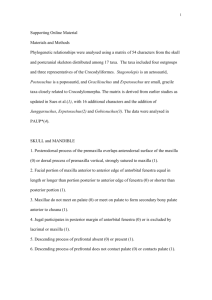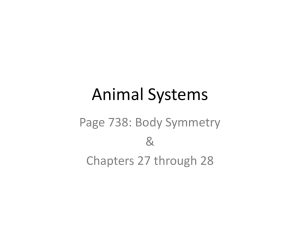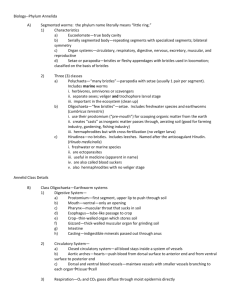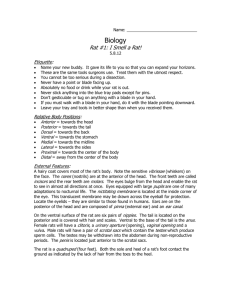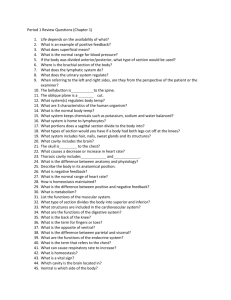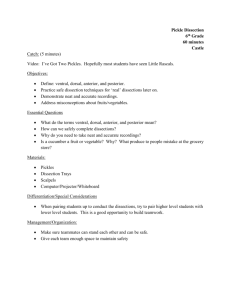Vol
advertisement
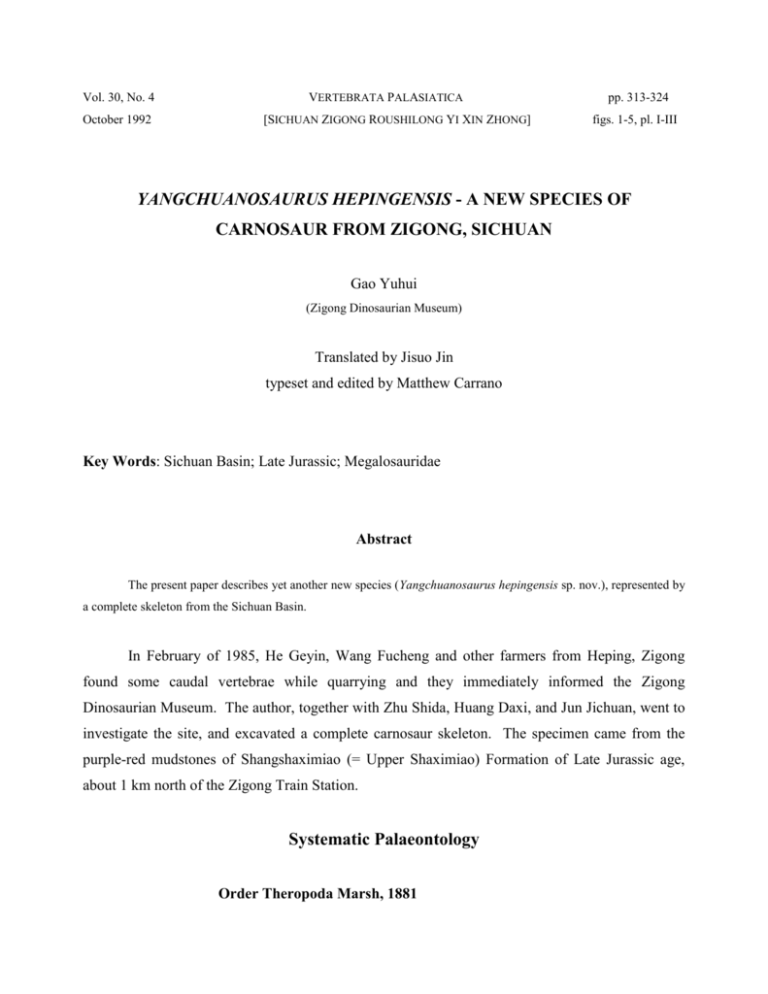
Vol. 30, No. 4 October 1992 VERTEBRATA PALASIATICA [SICHUAN ZIGONG ROUSHILONG YI XIN ZHONG] pp. 313-324 figs. 1-5, pl. I-III YANGCHUANOSAURUS HEPINGENSIS - A NEW SPECIES OF CARNOSAUR FROM ZIGONG, SICHUAN Gao Yuhui (Zigong Dinosaurian Museum) Translated by Jisuo Jin typeset and edited by Matthew Carrano Key Words: Sichuan Basin; Late Jurassic; Megalosauridae Abstract The present paper describes yet another new species (Yangchuanosaurus hepingensis sp. nov.), represented by a complete skeleton from the Sichuan Basin. In February of 1985, He Geyin, Wang Fucheng and other farmers from Heping, Zigong found some caudal vertebrae while quarrying and they immediately informed the Zigong Dinosaurian Museum. The author, together with Zhu Shida, Huang Daxi, and Jun Jichuan, went to investigate the site, and excavated a complete carnosaur skeleton. The specimen came from the purple-red mudstones of Shangshaximiao (= Upper Shaximiao) Formation of Late Jurassic age, about 1 km north of the Zigong Train Station. Systematic Palaeontology Order Theropoda Marsh, 1881 Superfamily Carnosauria Huene, 1920 Family Megalosauridae Huxley, 1869 Genus Yangchuanosaurus Dong, Zhang, Li et Zhou, 1977 Yangchuanosaurus hepingensis sp. nov. Diagnosis. Body large, reaching 8 m in length. Skull robust, facial portion low and long, with ratio of skull length/height of 1.75. Two antorbital fenestrae; first antorbital fenestra welldeveloped and elongated anteroposteriorly, forming an isosceles triangle; second antorbital fenestra small and rectangular in outline. Maxillary depression long and elliptical. Parietal strongly pronounced, with a well-developed posterior process. Supraoccipital narrow with a well-developed median ridge. Lacrimal tilted anteriorly, coming into contact with postorbital at the upper edge of the orbit. Dentary thick, strong, and relatively high. Teeth relatively small. Premaxillary and maxillary teeth with thin crowns; dental formula . 9 cervical vertebrae, opisthocoelous; posteriorly located cervical vertebrae bearing a ventral ridge. 14 dorsal vertebrae, with relatively short, amphiplatyan centra and high, laminar neural spines. 5 sacral vertebrae fused together. Caudal vertebrae amphicoelous, with long prezygapophyses in the middle and distal vertebrae. Scapular shaft wide. Ilium high, with anterior lobe curved ventrally. Pubic foramen small, and pubic foot short and broad. Ischium expanded distally. Materials. A fairly complete skeleton. Skull complete; 9 cervical, 14 dorsal, 5 sacral and 35 caudal vertebrae preserved in articulation; limb girdles almost completely preserved. Catalogue number ZDM 0024, deposited in the Zigong Dinosaurian Museum. Locality and Stratum. Tianwan Village, Heping, Zigong. Shangshaximiao (= Upper Shaximiao) Formation, Late Jurassic. Description 1. Skull. Completely preserved. Slightly compressed due to burial compression, and premaxilla and right mandible show slight displacement. Other bones well articulated with clear sutures. In lateral view, the skull is oval-shaped, with the antorbital area long and low, and the postorbital area high and short. Maximum length of the skull is 1040 mm, and the maximum height is 595 mm. In dorsal view, the skull is a long, narrow isosceles triangle in outline; the width between the left and right postorbital bones is 290 mm, representing the maximum width of skull. The portion anterior to the postorbital gradually narrows, but the postorbital area does not clearly narrow. The occiput is composed of the basioccipital, supraoccipital, exoccipital and paroccipital process. Basioccipital. Located in the lower part of the occiput, occupying about 2/5 of the total area of the occiput. The middle part of the basioccipital is depressed anteriorly, with the dorsal edge fused to the exoccipital and paroccipital process. The occipital neck bears a longitudinal groove; the basioccipital process is very strong, protruding from the ventral side of the occipital neck. Supraoccipital. Relatively small, occupying less than 1/5 of the occiput. Trapezoidal in posterior view, narrow dorsally (48 mm wide) and wide ventrally (80 mm). The anterior edge is fused to the posterior process of the parietal. A longitudinal median ridge is well developed on the dorsal side. The lower edge is covered by the proatlas, thus it cannot be determined whether it forms the dorsal margin of the foramen magnum. Exoccipital and paroccipital process. Relatively large, wing-shaped plates extending laterally and ventrally at about 45° from the central part of the occiput, becoming free at the distal end. From the center laterally, it comes into contact with the supraoccipital, parietal and squamosal respectively. Basisphenoid. Slightly tilted anteriorly, bearing a deep fossa in the posteroventral portion; combining with the basioccipital process to form a large chamber. The ventral side of the basisphenoid bears a pair of lateral foramina of elliptical shape. The basipterygoid process extends anteriorly and ventrally to the medial side of the pterygoid. Laterosphenoid. A pair of rectangular, flat bones above the basisphenoids, relatively narrow, with an anteroposterior width of 30 mm. The dorsal end is connected to the frontal and parietal, and the posterior end is slightly overlapped by the prootic. Orbitosphenoid. Small, flat bone located on the anteromedial side of the laterosphenoid, somewhat damaged. Presphenoid. Triangular, platy bones visible from the orbit, vertical; the surfaces bear a few pits; the anterior end is pointed and free; the posterior edge is connected to the basisphenoid. Prootic and opisthotic. The prootic is small and irregular in shape, located posterior to the laterosphenoid; the posterior edge is connected to the basioccipital and exoccipital, and the dorsal edge is connected to the opisthotic. The opisthotic is relatively large, 110 mm long, and triangular in lateral view; the dorsal edge is fused to the parietal, the posterodorsal edge is connected to the squamosal, and the posterior margin is attached to the paroccipital process. Stapes. A slender, rod-like bone found at the depressed junction of the prootic and opisthotic, with a diameter of 2 mm; the distal end is damaged; the preserved length is 50 mm. The proximal end inserts into the fenestra ovalis, extending posteriorly and ventrally along the paroccipital process. Pterygoid. Relatively large, 420 mm long; tripartite, similar to that of Allosaurus in shape. The quadrate ramus is flat, vertical, and expanded posteriorly to overlap the medial side of the quadrate. The palatine ramus extends horizontally anteriorly, and is laminar and fused to the posteromedial margin of the palatine in the first antorbital fenestra. The ventral process is wide proximally and narrows distally, extending from the base posteriorly and ventrally into the medial side of the mandible. Ectopterygoid. Hook-shaped, located on the lateral side of the pterygoid, expanded at the proximal end, and attached to the junction between the palatine and the ventral processes of the pterygoid. The distal end comes into contact with the medial side of jugal. Epipterygoid. Triangular, platy, located above the proximal and posterior end of the pterygoid, and vertically oriented. The dorsal end is pointed and free; the ventral end is relatively broad, partly overlapping the lateral side of the quadrate ramus of the pterygoid. Palatine. The lateral side of the palatine can be observed within the first antorbital fenestra, flattened due to compression. The dorsal end of the medial lobe is ear-shaped, long and narrow, with a thin dorsal margin and a thick ventral margin. The ventral portion of the palatine is handleshaped, divided into anterior and posterior lobes; the anterior lobe is connected to the medial side of the maxilla, and the posterior lobe to the medial side of the jugal. Vomer. A pair of long, narrow and flat bones, located on dorsal side of the oral cavity. The dorsal surface is weakly convex; the anterior end is relatively thick, protruding from the maxilla and attached to the medial side of the premaxilla; the posterior end extends to the ventral portion of the palatine. Parietal. Located on top of the skull, pronounced. The dorsal surface is relatively wide, forming a major part of the lateral walls of the braincase. The posterior processes are well developed, expanding laterally as wing-like structures. The anterior edge of the parietal is fused to the frontal. The length of the parietal 110 mm, the width is 180 mm. Frontal. Located anterior to the parietal, rhomboidal in dorsal view with a rough surface ornamented with fine lines. The length is 160 mm, and the width in the middle portion is 170 mm. The anterior margin is fused to the nasal, the anterolateral margin is fused to the prefrontal, and the posterolateral margin is fused to the postorbital. It does not form the dorsal margin of the orbit. The posterior central part of the frontal bears a short but wide process for muscle attachment. Prefrontal. A pair of small bones located on the anterolateral sides of the frontals, relatively long and slender with pointed anterior ends. The lateral edge is connected to the lacrimal, the anteromedial side to the nasal, the posteromedial side to the frontal, and the posterior side with the postorbital. It does not bound part of the dorsal edge of the orbit. Nasal. Long, narrow, 620 mm long, and attaining more than half of the total skull length. The surface is rough, with elliptical fossae on both sides. The anterior end forms a Y-shaped notch to connect with the ascending process of the premaxilla. The lateral side of the nasal and maxilla are connected through a long contact surface. The posterolateral side contacts the lacrimal and prefrontal, and the posterior side is fused to the frontal. Premaxilla. An irregular rectangle in outline, weakly convex on the lateral surface. The anterior end bears a rod-like ascending process, tapering posterodorsally to insert into the Y-shaped notch of nasal, forming a nasal crest. The posterodorsal end has a small, flat process that extends into the medial side of the maxilla. The surface of the premaxilla is rough, with well-developed nutrient foramina. The height from the dental edge to the nasal naris is 118 mm, and the length in the anteroposterior direction is 110 mm. Maxilla. Triangular, low and long. The ascending process is slender and directed posterodorsally; the dorsal edge contacts the nasal, the posterior edge is connected to the lacrimal to bound the dorsal margin of the orbit. The basal part of the ascending process bears a small, rectangular opening, 70 mm long, which is the second antorbital fenestra; the posterodorsal part has an elliptical maxillary depression that is pierced through anteriorly. The surface of the maxilla is irregular with clear nutrient foramina. The length of the maxilla is 570 mm, and its height is 310 mm. Lacrimal. T-shaped, with an irregular surface. Two small fossae are present on the lateral side of the basal portion. The lateral side of the anterior process is irregular with tubercles, and the ventral edge is relatively smooth. The ventral process is tilted anteriorly, with a slightly expanded distal end connected to the posterior process of the maxilla and the medial side of the jugal. The posterior process is rough, in contact with the anterior end of the postorbital. Postorbital. Triradiate, located on both sides of skull, forming the posterodorsal margin of the orbit. The anterior process is pronounced, with its anterior end contacting the lacrimal. The ventral process is long and slender, connected with the ascending lobe of the jugal. The posterior process is rod-shaped, and the fused to anterolateral process of the squamosal. Squamosal. Located on the lateral side of the parietal, tetraradiate. The anterolateral process is relatively thick, and fused to the postorbital to form the boundary between the upper and lower temporal fenestrae. The anteromedial process is relatively slender, connected to the parietal and opisthotic. The ventral process is flattened, and tilted ventrally to contact the quadrate and quadratojugal. The posterior process is short. The surface of the squamosal is rough, with a small transverse ridge near the base. Quadratojugal. L-shaped, with a smooth surface. The posteromedial edge is fused to the lateral side of the quadrate. The dorsal process is long and slender, with its dorsal end contacting the posterior part of the ventral process of the squamosal. The jugal process extends horizontally anteriorly, tapering distally. The length of the quadratojugal is 230 mm, and the height is 200 mm. Quadrate. A pair of relatively long bones on both sides of the occiput. The ventral end is widened horizontally; the articular surface are gently rounded and smooth. A laminar part protrudes anteriorly from the dorsomedial part of the quadrate, relatively wide and weakly curved medially, its medial side overlapping onto the posterior end of the quadrate ramus of the pterygoid. The ventromedial part of the quadrate bears a small fossa on its posterior side. The maximum width of the quadrate at its end is 107 mm. Jugal. Triradiate; the anterior process is thin, wide, flat, and connected to the posterior end of the maxilla and the ventral end of the lacrimal; the ascending process is sharply pointed, and connected to the posterior side of the ventral process of the postorbital; the posterior process of the jugal contacts the medial side of the quadratojugal. Table 1. Skull measurements of Yangchuanosaurus hepingensis (in mm): feature maximum length of skull measurement 1040 maximum height of skull 595 width at top of orbit 290 maximum width between paroccipital processes 260 length of quadrate 256 height at middle part of maxilla 250 Table 2. Measurements of left mandible of Yangchuanosaurus hepingensis (in mm): feature measurement maximum length of mandible 1000 maximum height of mandible 198 anterior height of dentary 94 distance between mandibular fenestra and anterior end 570 length of external mandibular fenestra 165 width of external mandibular fenestra 72 Mandible. The right mandible is slightly displaced, with the dentary separated. The left mandible is well articulated. They are strong and robust, with a large mandibular fenestra. Dentary. Relatively long, 620 mm, reaching more than half of mandibular length. Relatively high; the ventral edge is thick, with a maximum thickness of 48 mm. Meckel's canal is clearly shown on the medial side, and nutrient foramina are prominent on the lateral side. The posterior end of the dentary is expanded and bifurcated, with the dorsal process connecting with the surangular and the ventral process covering the anterior end of the angular. Angular. Flat, located on the lateral side and near the posterior end of the mandible. The surface is smooth. The anterior end is low, extending to the medial side of the dentary; the anterodorsal edge bounds the dorsal margin of the mandibular fenestra. The posterior end is thin and expanded; the medial side is attached to the surangular and prearticular. The ventral edge of the angular is thick and curved medially. Surangular. A relatively large bone in the posterolateral part of mandible, 500 mm long and 141 mm wide. The dorsal edge is thick and the ventral edge is thin; the anterior end extends anteriorly to become flat and connect to the posterodorsal process of the dentary. The middle portion of the surangular is relatively wide; the ventral edge bears a fairly large notch to form the posterodorsal margin of the mandibular fenestra. The posterior part of the surangular bears a longitudinal crest near the dorsal edge of the lateral side. The surangular foramen is located below this crest. Prearticular. Located on the medial side of the posterior mandible, long, curved and 500 mm in length. The middle part is thick and both ends are expanded. The anterior end is flat, contacting the posteromedial side of the dentary; the posterior end is thickened, protruding, and connected to the medial sides of the articular and surangular. Splenial. Triangular, platy and 470 mm long. It tapers anteriorly and extends to a level 160 mm from the anterior end of the dentary. The posterior end is expanded and tightly attached to the medial dentary. A small foramen is present on the medial side and near the ventral edge in the middle portion of the splenial. Coronoid. Cannot be observed because it is covered by the surangular. Articular. A small, thick and irregular bone at the end of the mandible. 2. Major openings of skull. Nasal naris. Laterally located, oval, 154 mm long, 65 mm wide, its margin is defined by the premaxilla and nasal bones. Second antorbital fenestra. Small, rectangular, 70 mm long, 26 mm wide, and located at the base of the ascending process of the maxilla. First antorbital fenestra. The largest opening of skull, elongated anteroposteriorly to form an isosceles triangle, with a maximum diameter reaching 335 mm. Its margin is mainly formed by the maxilla and lacrimal, with a small lower posterior portion formed by the jugal. Orbit. Relatively narrow, 245 mm in height, anteroposterior length 107 mm, and maximum anteroposterior diameter occurring in the ventral middle part. Its boundary is formed by the lacrimal, postorbital and jugal. Lower temporal fenestra. Relatively large, with the dorsal end slightly narrower than the ventral; the anteroposterior length is 95 mm at the dorsal end, 103 mm at the ventral end, and 124 mm at the middle ventral portion. The height is 290 mm. Upper temporal fenestra. Small, subcircular, 85 mm in diameter, and opening dorsally. 3. Teeth. Perfectly preserved. 4 left premaxillary teeth, 13 maxillary teeth, and 16 complete dentary teeth. Dental formula: . Teeth laterally compressed, crowns weakly curved posteriorly, serrated on anterior and posterior edges, with 24 denticles per 10 mm. Premaxillary teeth. Long and slender in lateral view, circular in cross-section. The second left tooth is the longest, 60 mm; the diameter at the base of the crown is 22 mm. Maxillary teeth. Flattened, with a thickness less than 2/3 or even 1/2 of the width. The fourth tooth is 61 mm long, with the width at the base of the crown 28 mm, and thickness 13 mm. Dentary teeth. Intermediate in shape between the premaxillary and maxillary teeth. The anteriorly located teeth are similar to the premaxillary teeth in being subcircular in cross-section; the middle and posterior teeth become elliptical in cross-section but are not as flattened as the maxillary teeth. Some lower teeth bear a deep, longitudinal groove on the lingual side of the basal part. 4. Vertebral column. Almost completely preserved, including 23 articulated presacral vertebrae, 5 fused sacral, and 35 articulated caudal vertebrae. 1) Cervical vertebrae. 9 vertebrae, with a total neck length of 890 mm. Proatlas. A pair of small, triangular, platy bones fused medially along a short surface of 5 mm; the lateral edge is long (65 mm); the distal end is pointed. Located at the foremost of the cervical vertebral series, with its anterior margin closely attached to the supraoccipital and exoccipital, and surrounding the foramen magnum. Atlantal intercentrum. Rectangular in ventral view, slightly concave, anteroposterior length 30 mm, width 70 mm. The anterior side is articulated with the occipital condyle; the posterior side is connected to the axial intercentrum. Neural arch. Strong, with its base attached to both sides of the atlantal intercentrum, becoming slender posterodorsally; the ventral side at the apex is articulated with the anterior articular surface of the axis. The anteroposterior length of the arch id 100 mm; its height is 90 mm. Odontoid process. Cannot be observed because it is covered by the neural arch. Axial intercentrum. Located anterior to the axis, and wedge-shaped in lateral view; the dorsal end is pointed, and the ventral end is thick. anteroposterior length is 30 mm, and the width is 80 mm. It is lip-shaped in ventral view. Its Axis. Concave at the posterior end; with a well-developed pleurocoel. The middle part of the centrum is constricted. The neural arch is moderately high. The neural spine begins in front of the neural arch, extending posteriorly, and expanding dorsolaterally to form a triangular roof; the posterior portion of the roof is enlarged into a deltoid structure. The diapophysis is moderately developed; the parapophysis is located on the anterior part of the centrum. Third to seventh cervical vertebrae. Similar in morphology to each other; opisthocoelous, with the anterior end hemispherical and the posterior end depressed like a cup. The middle part of the centrum is constricted; the ventral side is sloping; the pleurocoel is prominent. The neural spines are laminar, tilting slightly posteriorly. The sixth neural spine is the largest. The prezygapophyses are pronounced beyond slightly anterior edge of slightly centrum, with a large, elliptical articular surface. The postzygapophyses are long, with a well-developed upper lobe. The diapophyses are located near the ventral part of the centrum; the parapophyses are located near the ventral edges in the anterior part of the centrum. Eighth and ninth cervical vertebrae. These become stronger, with a well-developed ventral ridge. The neural arches become rod-like. The distance between the pre- and postzygapophyses is reduced. The diapophyses have migrated dorsally onto both sides of the neural arch. The parapophyses are located in the anteroventral part of the centrum. 2) Dorsal vertebrae. 14 complete and articulated dorsal vertebrae; the total length of the dorsal column is 1550 mm. First to third dorsal vertebrae. Similar to the posterior cervical vertebrae; the centrum is short, and weakly concave at the posterior end, with a prominent ventral ridge and a weak pleurocoel. The neural spine is rod-like, and the diapophyses are raised, becoming fairly strong in the second and third vertebrae. The parapophysis extend dorsally from the anteroventral edge. Fourth to 14th dorsal vertebrae. Flat on both sides. The ventral middle portion is slightly narrowed. The pleurocoel is weak. A ventral ridge is present in the fourth but absent from the fifth vertebra. The fifth to seventh centra are relatively small and narrow, becoming larger posteriorly. The neural spines are laminar, relatively high, with a rough apex, a small longitudinal lateral ridge, and a groove in the posterior portion. The neural spines become higher posteriorly, reaching their highest in the 13th vertebra (270 mm high, 120 mm wide). The anterior and posterior articular surfaces are nearly horizontal. The diapophysis tilts posteriorly, more so in the anterior and middle than in the posterior vertebrae. The parapophyses are elevated onto both sides of the neural arch. 3) Cervical ribs. The distal ends are more or less damaged due to weathering. These are three-headed; the shaft is long, slender and straight, with the lateral surface convex, the medial side flat, and a flattened cross-section. The third cervical rib is 440 mm long, with its distal end extended beyond the posterior end of the 5th vertebra; the capitulum and tuberculum are relatively weak and closely spaced. The middle and posterior ribs gradually become thicker and shorter; their tuberculum and capitulum become stronger and wider apart. 4) Dorsal ribs. Completely preserved, 14 on each side. These are double-headed; the shaft is long, curved medially and subelliptical in cross-section, with the tuberculum shorter and larger than the capitulum. The first dorsal rib is 530 mm long and relatively straight, with the tuberculum and capitulum fairly close to each other. The second dorsal rib is 900 mm long and lacks a clear ridge on shaft, with its tuberculum and capitulum strong and farther apart; the distal end is flattened. The sixth rib is 960 mm long, with a clear ridge, and both the tuberculum and capitulum are well-developed; the distal end is flattened. Posteriorly located ribs become slender and shorter; the 12th and 13th ribs reach only 400 and 250 mm; their distal ends are thin and rod-like; the tuberculum and capitulum are small and weak. 14th rib small, short, with end connected to ilium. 5) Ventral ribs. Only one incomplete ventral rib was found, 530 mm long and whipshaped, with its shaft slightly curved and circular in cross-section; it is enlarged in its middle portion, becoming slender toward the end; a weakly thickened tuberculum is present at 200 mm from the middle. 6) Sacral vertebrae. The five sacral vertebrae are fused together; they are flat at both ends. The second to fourth centra are short, with a strong narrowing in the middle. The first and fifth centra are large, thick, and not constricted in middle. Sacral ribs are developed and closely attached to ilium. The five neural spines are laminar and fused together. 7) Caudal vertebrae. There are 35 fairly complete articulated vertebrae, with only a few neural spines missing. First to fifth caudal vertebrae. The centra are strong and amphicoelous, with the anterior end more deeply concave than the posterior; the centra are higher than long, each bearing a longitudinal groove on the ventral side. The neural spine is tall, laminar and tilted posteriorly. The caudal ribs are large and attached to the neural arches; the distal ends are flat, tilting posterodorsally. Sixth to 23rd caudal vertebrae. Amphicoelous, longer than high; the height increases, the length decreases, and the centra become nearly cylindrical from the anterior to the posterior vertebrae. The ventrolateral depression is shallow. The neural spines gradually become smaller and lower; the spine of the 14th vertebra is divided into two parts - a small, pointed, anteriorly directed anterior part, and a flat, very small posterior part. The caudal ribs become reduced in size posteriorly. The pre- and postzygapophyses become longer anteroposteriorly; the prezygapophysis face dorsally, and the articular surface faces medially. 24th-35th caudal vertebrae. Amphicoelous; the centra are long and low, with the length 2-3 times greater than the width; the ventrolateral depression slowly disappears. The neural spines gradually becomes lower; the 25th neural spine is already lower than the prezygapophysis, and has totally disappeared in the 30th vertebra. The caudal ribs have totally disappeared. The prezygapophyses are much larger than the postzygapophyses in the posterior vertebrae. 8) Haemal arches. Poorly preserved and mostly damaged, only a few are complete and articulated with the caudal vertebrae. The haemal arches do not bifurcate; they are blade-like in lateral view; broad at the dorsal and ventral ends; and the distal end curves posteriorly. They are Y-shaped in anterior view. 9) Shoulder girdle. The left and right scapulae and coracoid are well preserved and in their original articulation. 10) Scapula. The blade is wide and curved medially, with expanded proximal and distal ends; the medial side is flat, and the lateral side is convex, with the ventral edge thicker than the dorsal edge. The maximum thickness of the articular glenoid is 80 mm. The articular line of the scapula with the coracoid is convex anteriorly. The left scapula shows an abnormal shape due to secondary bony growth; the middle part of the shaft becomes very thick, and both ends are prominently expanded. 11) Coracoid. Oval in outline; the ventral edge is thicker than the dorsal edge; the medial side is clearly concave anteroposteriorly, and the lateral side is correspondingly convex. The coracoid foramen pierces through, with its lateral diameter larger than the medial. A small process is present below the foramen. 12) Pelvic girdle. articulation. Strong and robust, with the ilia, ischia and pubes preserved in Table 3. Measurements of scapulae and coracoids of Yangchuanosaurus hepingensis (in mm): scapula coracoid feature left right length 760 740 width of proximal end 225 219+ width of distal end 206 147+ minimum width of shaft 120 105 length (vertical) 200+ 250 maximum width (anteroposterior) 160 160 13) Ilium. Fan-shaped; the medial side is reduced in size and articulated with the sacral ribs. The ventral edge of the ilium is thicker than the dorsal edge; the anterior lobe is short, broad and curved ventrally, forming a relatively narrow angle with the pubic peduncle. The pubic peduncle is strong, convex anteriorly and concave posteriorly, and located near the anterior end of the ilium. A ridge begins at the proximal end of the pubic peduncle, forming the dorsal edge of the acetabulum; the ridge extends posterodorsally to thicken the dorsal edge of the acetabulum. The ischial peduncle is shorter than the pubic peduncle. The height of the ilium above the acetabulum is 420 mm. 14) Pubis. The proximal end is expanded, and the articular surfaces for the ilium and ischium are robust, with the surface for the ilium longer than that for the ischium. The pubic foramen is relatively small; the shaft of the pubis is long, slender and comma-shaped in crosssection; its lateral margin is thick and smooth, and the medial margin is thin. The pubis is directed anteroventrally; the pubic foot at the distal end is short and wide. 15) Ischium. Shorter and thicker than the pubis; the articular surfaces with the ilium and are pubis robust. The proximal end is enlarged, with a process at its anteroventral edge. The two ischia are fused along the midline from this process to the distal end. The anterior edge of the shaft is thicker and stronger than the posterior edge; the crest for muscle attachment at the distal end is enlarged. 16) Femur. The shaft is slightly curved anteriorly and oval in cross-section. The femoral head is well developed. The lesser trochanter is located on the anterolateral side of the proximal end, separated from the shaft by a groove. The fourth trochanter is a rough longitudinal crest on the posterior side of the femur. The medial condyle is larger than the lateral condyle at the distal end, and the two are separated by an intercondylar groove. The length of the femur is 980 mm, its distal width is200 mm, and its width at mid-length is 120 mm. Comparison and Discussion Specimen ZDM 0024 shows megalosaurid characteristics in its skeletal structures: a relatively large size, and a large skull with a moderate height/length ratio. The ventral process of the squamosal tilted is downward; the ventral process of the postorbital is relatively slender. The mandible is strong, bearing a mandibular fenestra. The teeth are laterally compressed, and serrated anteriorly and posteriorly. There are nine opisthocoelous cervical and fourteen amphiplatyan dorsal vertebrae; five fused sacral vertebrae; and amphicoelous caudal vertebrae. The pelvic girdle is strong; the pubis is long and slender, with a moderately developed pubic foot; the ischium has an enlarged distal crest for muscle attachment. Yangchuanosaurus was established by Dong et al. (1977) and includes Y. shangyouensis and Y. magnus, both of which are from the Late Jurassic Shangshaximiao Formation of Yongchuan County; they are of the same age as the Zigong specimen. The straight-line distance between the Yongchuan and Zigong localities is less than 120 km. Specimen ZDM 0024 shows many important features of Yangchuanosaurus: the skull is strong and robust with a moderate height/length ratio and six pairs of openings; the nasal naris is oval; the lateral temporal fenestra is medium-sized, with its greatest anteroposterior width located in the ventral middle part. The maxilla bears a depression. The parietal crest is high, with a welldeveloped posterior process. The frontal and parietal are fused. The mandibular fenestra is large. There are four premaxillary teeth, and the maxillary teeth do not exceed 15. The cervical vertebrae are opisthocoelous, and the dorsal vertebrae are amphiplatyan. The dorsal neural spines are rectangular, flat and tall. Five sacral vertebrae are fused together. The caudal vertebrae are amphicoelous, with high neural spines in the anterior caudal vertebrae. The pelvic girdle is strong; the pubes and ischia are fused; the pubic foot is moderately developed. According to these characteristics, specimen ZDM 0024 is assigned to Yangchuanosaurus. Compared to Y. shangyouensis, the Zigong specimen differs clearly in a number of characteristics (Table 4). Table 4. The differential diagnosis for Y. hepingensis with Y. shangyouensis species diagnosis Y. hepingensis Y. shangyouensis 41% 31% length ratio of skull/presacral vertebrae first antorbital fenestra anteroposteriorly elongate, isosceles triangle equilateral triangle second antorbital fenestra rectangular triangular teeth relatively small, flattened relatively large, robust dentary relatively high very low dorsal vertebrae 14, centra short 13, centra relatively long ilium pubis high pubic foot short, wide pubic foramen small low pubic foot long, slender pubic foramen large The Zigong specimen differs from Y. magnus mainly in the following characteristics: Y. hepingensis has a long, low maxilla with an elongated, elliptical maxillary depression; the first antorbital fenestra is stretched anteroposteriorly into an isosceles triangle; the second antorbital fenestra is rectangular; the teeth are relatively small, and the maxillary teeth are thin in crosssection. The ilium is relatively high and short, and the femur is relatively long and thin. In Y. magnus, the maxilla is high, with a triangular maxillary depression; the first antorbital fenestra is not elongated, and the second antorbital fenestra is triangular; the teeth are thick and strong, and the maxillary teeth are thick and robust; the ilium is long and narrow; the femur is short and thick. Y. magnus is represented by very incomplete material, and further detailed comparison is difficult. The new species is proposed and named after the type locality: Yangchuanosaurus hepingensis n. sp. The text-figures were prepared by Yu Yong, and plates by Yu Gang. Dong Zhiming, Zhang Yihong, Gao Renyan, and Zhu Shida offered help and support during preparation of the manuscript. The author thanks them all. (Manuscript received May 28, 1991) References He, Xinlu, 1984. Vertebrate fossils of Sichuan, p. 46-55. Sichuan Sciences and Technology Publishing House. Dong, Zhiming, Zhang, Yihong, Li, Xuanmin, and Zhou, Shiwu, 1978. A new carnosaur from Yongchuan County, Sichuan. Ke Xue Tong Bao [Science Newsletter], v. 23, no. 5, p. 302-304. Dong, Zhiming and Tang, Zhilu, 1984. Szechuanosaurus fauna from Dashanpu, Zigong, Sichuan, Brief Report IV, Theropoda. Vertebrata PalAsiatica, v. 23 (1), p. 77-83. Dong, Zhiming, Zhou, Shiwu, and Zhang, Yihong, 1983. Jurassic Dinosaurian fossils from the Sichuan Basin. Palaeontologia Sinica, v. 162, ser. C, no. 23, p. 56-88. Science Publishing House. Gilmore, C. W., 1920. Madsen, J. H., Jr., 1976.


